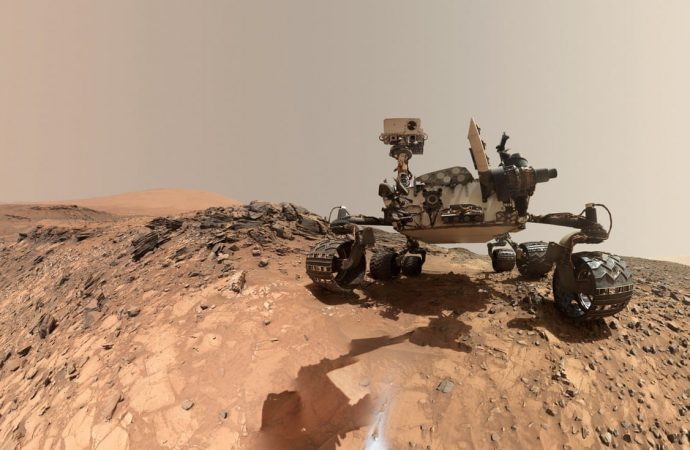Gas detected by Curiosity rover may have been released from fractured Martian permafrost
Source: The Guardian
A waft of methane detected by Nasa’s Curiosity rover on Mars may have been released from a layer of permafrost containing bubbles of the gas that was fractured by a geological event, researchers have said.
It is the first time scientists have identified a potential source of methane on Mars, though the scientific community is still divided on whether the gas is really produced on the planet at all. Some says the methane detections on Mars are spurious or have come from other sources such as the rover itself.
On 16 June 2013, instruments on Curiosity recorded a spike in methane in the Gale crater, a 96-mile-wide bowl where the rover landed in August 2012. Since then, it has found evidence of seasonal variations in methane, with levels of the gas rising and falling with the Martian summers and winters.
The apparent presence of methane on Mars has fuelled intense speculation that the gas could emanate from microbial Martians beneath the surface, though a more prosaic explanation points to a reaction between olivine rocks and water. Both processes release the gas on Earth.
In the latest study, Marco Giuranna and colleagues at the National Institute of Astrophysics in Rome turned to an instrument on the European Space Agency’s Mars Express orbiter to look for more evidence of methane on Mars.
The scientists used the orbiter’s planetary fourier spectrometer (PFS) to look for methane in and around Gale crater from December 2012 to July 2014. The instrument spotted methane only once, on the same day Curiosity detected the sudden spike in the gas.
“Our finding constitutes the first independent confirmation of a methane detection,” Giuranna said. “Prior to our study, methane detections on Mars, being either in situ, from orbit, or from Earth-based telescopes, were not confirmed by independent observations.”
While the Curiosity rover measured a methane concentration of 5.78 parts per billion (ppb) in Gale crater on 16 June 2013, the Mars Express instrument recorded 15.5ppb in the column of atmosphere above the crater, the scientists report in Nature Geoscience.
In an attempt to trace the source of the methane, the scientists divided up a wide region around Gale crater into a grid with squares 250km on each side. Researchers at the Royal Belgian Institute for Space Aeronomy in Brussels used computer models to simulate one million different emission scenarios in each square. Meanwhile, geologists in the US and Italy scrutinised the region around the crater for features that might release methane.
“Remarkably, we saw that the atmospheric simulation and geological assessment, performed independently of each other, suggested the same region of provenance of the methane, which is situated about 500km east of Gale,” said Giuranna. The location, known as Aeolis Mensae, has a number of geological faults that may have fractured nearby permafrost and released any methane trapped inside. Alternatively, incoming meteorites might have broken the ice open.
The study does not speculate about the ultimate origin of methane on Mars, but Giuranna said homing in on a source was the first step towards an answer. Even if microbes were not the culprit, he said, the gas would make the planet more habitable because it could be used as a source of carbon and energy. Humans could also potentially make use of methane trapped beneath the Martian soil to make chemicals and rocket fuel.
The results are likely to stoke the debate on the existence of Martian methane. In December, researchers working on the European Space Agency’s ExoMars Trace Gas Orbiter (TGO) said they had not detected any methane in the Martian atmosphere since the spacecraft arrived in orbit in 2016. Their findings suggest methane releases are extremely rare and that the gas swiftly disappears.
“The findings are somewhat of a surprise,” said Manish Patel, an Open University researcher who works on the TGO mission. “Comparing these results to what we see with the specifically designed methane hunting instruments on TGO will tell us a lot.”
The TGO mission, which could potentially distinguish between microbial and geological sources of methane, will release its results next week.
“The verification of the Curiosity observations by the PFS instrument certainly gives us a lot to think about,” said Patel. “Let’s just say it will make for an interesting discussion in the community as we seek to resolve the observations from existing and new measurements of methane on Mars.
“As always, Mars and the scientists that study it still have plenty of surprises up their sleeves.”

































Leave a Comment
You must be logged in to post a comment.